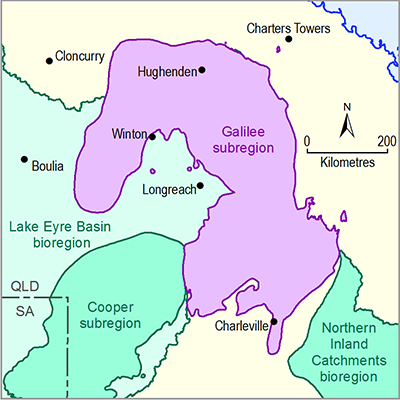The numerical simulation of the hydrological changes due to the coal resource development pathway (CRDP) at the identified model nodes necessitates the development of an integrated surface water – groundwater modelling approach. The groundwater and surface water, however, operate at very different spatial and temporal scales. The surface water obviously is bound to river channels and floodplains. Streamflow is very responsive to individual rainfall events, requiring at least a daily temporal resolution to capture its ephemeral nature. Groundwater dynamics in the alluvial and Cenozoic deposits are mostly local and controlled through interactions with surface events, such as high rainfall or flooding (see Section 2.1.5 in companion product 2.1-2.2 for the Galilee subregion (Evans et al., 2018a)). Capturing this dynamic in a numerical groundwater model requires at a minimum a monthly resolution.
The deeper hydrogeological units hosted in the Eromanga and Galilee basins are much more extensive, both horizontally and vertically. The groundwater dynamics are very slow. In the outcrop zones of the units, there are indications that groundwater levels are influenced by recharge events. In the deeper, confined parts of the hydrogeological units there is no indication that groundwater dynamics are affected by recharge and discharge processes. Simulating groundwater flow in the deeper hydrogeological units requires a spatially extensive model, but a high temporal resolution is not essential.
While fully coupled surface water – groundwater model codes are available (e.g. Hydrogeosphere, Brunner and Simmons, 2012), their use was not deemed to be justified within the Bioregional Assessment Programme due to the high data requirements for parameterisation and due to operational constraints. The latter relates mainly to the general numerical instability of such models and long runtimes which would severely limit a probabilistic uncertainty analysis that requires the models to be evaluated hundreds of times with vastly different parameter sets.
For this Assessment, a pragmatic coupling of two models was developed. The models consist of a regional groundwater model to simulate the change to the groundwater systems of the subregion and a rainfall-runoff model to simulate the change to the surface water systems of the subregion (Figure 3). The individual models have different spatial and temporal resolution which requires a set of customised processing steps to upscale or downscale model data to allow the models to be linked.
Figure 3 Model sequence for the Galilee subregion
GW AEM = regional groundwater analytic element model; AWRA-L = rainfall-runoff model; dmax = maximum difference in drawdown for one realisation within an ensemble of groundwater modelling runs, obtained by choosing the maximum of the time series of differences between two futures; tmax = year to maximum change; ΔQb = change in surface water – groundwater flux; Qtb = total streamflow baseline; Qtc = total streamflow CRDP; ΔHRV = change in hydrological response variable; CRDP = coal resource development pathway; GW = groundwater; SW = surface water
The regional groundwater model is an analytic element model (referred to as GW AEM), designed to simulate the change in drawdown at the groundwater model nodes shown in Figure 3 and the change in surface water – groundwater flux. This model is explained in detail in companion product 2.6.2 for the Galilee subregion (Peeters et al., 2018). As there is no coal resource development under baseline conditions, the drawdown and change in surface water – groundwater flux due to baseline coal resource development is zero. There is therefore no need for a separate baseline conditions run for the groundwater model. The change in surface water – groundwater flux simulated with the CRDP run of the analytic element model, ΔQb, is taken into account in the AWRA-L surface water model generated streamflow. The change in a number of hydrological response variables is modelled at the surface water model nodes. The modelling of river management or routing of streamflow through the river network with a river model is not necessary as the salient features of streamflow can be simulated solely with a rainfall-runoff model (see companion submethodology M06 (as listed in Table 1) for surface water modelling (Viney, 2016)).
The AWRA-L baseline run simulates streamflow at surface water model nodes without any active mines. The AWRA-L CRDP run simulates streamflow at the surface water model nodes incorporating the effect of modelled open-cut and underground coal mines in the CRDP. The time series of baseline and CRDP streamflows are summarised in the nine hydrological response variables to highlight different aspects of the hydrograph. The differences between baseline and CRDP of these hydrological response variables will inform the receptor impact models for the surface water model nodes.


